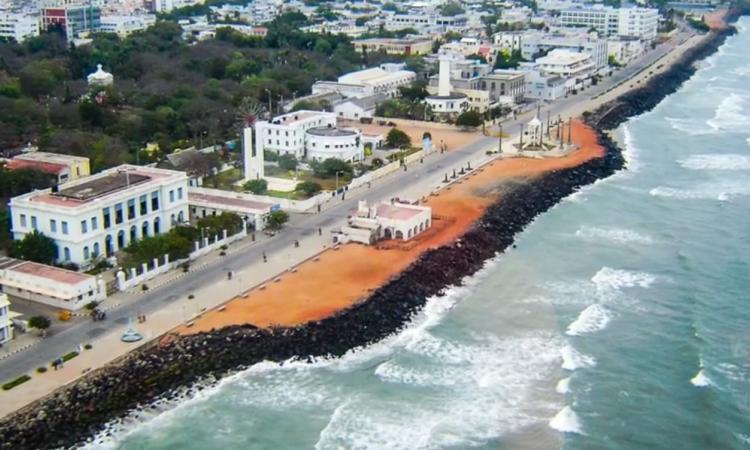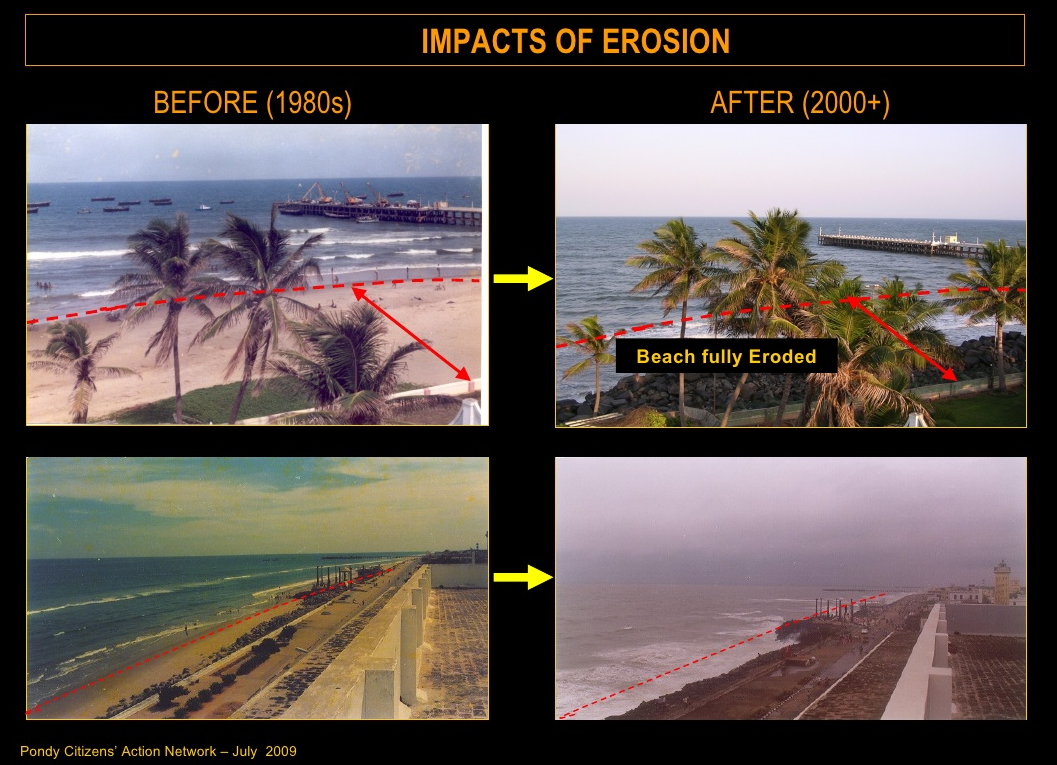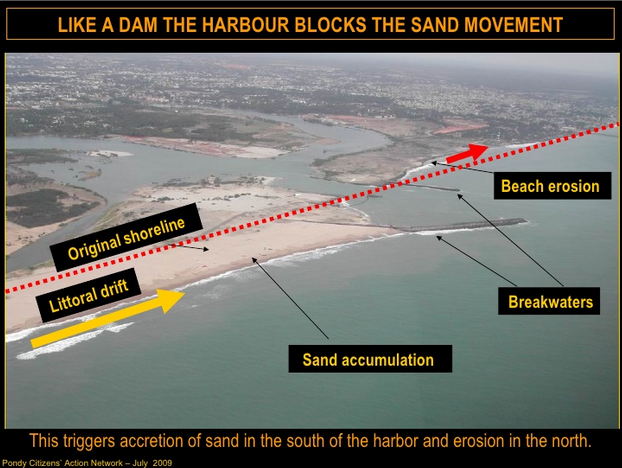
Life without sandy beaches is hard to imagine for artisanal fishermen. Beaches serve as boat-landing sites, net-repair yards, as spots to sort and dry fish, all at once. Increased erosion and the resultant loss of beaches essentially means loss of traditional livelihoods, all across the country’s densely-populated coast.
Not just fish workers, beaches are crucial for the survival of various other terrestrial and marine species. They provide safe nesting sites for turtles and migratory birds. The presence of a sandy barrier along the coast keeps seawater from intruding underground. As erosion increases, the risk of seawater intrusion increases as well. Beaches also function as buffers, reducing the fury of natural calamities such as cyclones, tsunamis and storm surges.
One of the rapidly changing coastlines in the country, the story of Puducherry’s coastline is over two centuries old. The French first constructed a masonry seawall in the 1700s to protect their settlement from the advancing sea. Ever since, seawalls and breakwaters have dotted the coast, with over a quarter of Puducherry’s coastline now secured by artificial protection.
The National Atlas and Thematic Mapping Organisation estimates that 32.3 percent of the entire length of the Pondicherry district coast is occupied by seawalls and groynes. In addition, the construction of the Puducherry harbor necessitated the presence of such hard structures to insulate the infrastructure from the sea.
Efforts of the French to embank the coast and natural causes aside, Pondy’s beaches have been disappearing rapidly in the last few decades. Reckless tinkering with the coastline, such as the construction of the artificial minor port in the late 1980s has greatly contributed to this disturbing trend.
 Embankments kill natural infrastructure
Embankments kill natural infrastructure
The silt and sand load of rivers get deposited along the coast, forming sandy beaches all along. It is estimated that the Indian coastline receives close to a billion tonnes of sediment every year. And similar to wave action, sand is also in constant motion. Coastal sediments get transported cyclically and systematically--termed as longshore drift--depending on the prevailing wind direction and wave action. For example, when winds travel in a southeasterly direction, the sand gets transported up the coast in a south to north motion; the direction is reversed when the northeasterly winds blow during the latter part of the year when the sand moves back from the north to the south.
“Natural infrastructure evolves over millennia. The sandy beaches we see today are the product of several million years’ work in progress; of sedimentation and continuous wind and wave action. And, there’s nothing more insidious and long-lasting than coastal erosion,” remarks Aurofilio Schiavina, a devoted sea lover from Pondy Citizen's Action Network (PondyCAN).
While not all erosion is anthropogenic, the changes are much more rapid compared to natural processes which are more gradual and cyclical. Schiavina terms anthropo-enabled sea erosion as insidious as chunks of landmass are lost in the sea; where there is no landmass, there is nothing left to remediate. While options do exist for limited reclamation, they either are too expensive or may prove to be detrimental to coastal stretches nearby.
Artificial protection
By installing hard structures such as breakwaters and jetties perpendicular to the coast, the Puducherry harbour interfered with the natural movement of sand along the coast. The sand continues to accumulate on one side of the harbour (south, in Puducherry’s case), while the opposite side is deprived of sand inflow, resulting in the loss of sandy shore and beaches due to non-replenishment.
Historically, putting up hard structures such as groynes have been the most preferred options to armour the coast. But what they effectively do is protect the portion of the coast where they are present while exposing uncovered stretches to excessive erosion, thereby devastating the coastline and dependent ecosystems. “To arrest the erosion, the Puducherry government decided to install seawalls all along its coast. But erosion knows no boundary, it spreads like cancer. The solid seawalls have pushed the erosion further north into the Kotakuppam area, which falls in the neighbouring state of Tamil Nadu,” notes Schiavina.
Beach nourishment, where sand is artificially deposited in deprived stretches, is a promising but a costly alternative. In Puducherry too, engineers had designed such a system to transport excess sand from the south of the harbour to the northern coast to make up for disrupting the longshore drift. However, it did not continue for long, resulting in the total loss of sandy beaches north of the harbour.
 “Armouring the coast with groynes essentially means putting up a fight against the sea. With coastal restoration, on the other hand, one tries to work with the sea and not against it. Though beach nourishment involves a substantial recurring expenditure, it is relatively more eco-friendly when it comes to keeping the coastline intact. The significant part is that the secondary impacts caused by seawalls and groynes end up costing more than the recurring cost of beach nourishment; yet somehow the government tends to be biased in favour of the former,” adds Schiavina.
“Armouring the coast with groynes essentially means putting up a fight against the sea. With coastal restoration, on the other hand, one tries to work with the sea and not against it. Though beach nourishment involves a substantial recurring expenditure, it is relatively more eco-friendly when it comes to keeping the coastline intact. The significant part is that the secondary impacts caused by seawalls and groynes end up costing more than the recurring cost of beach nourishment; yet somehow the government tends to be biased in favour of the former,” adds Schiavina.
Eroding coastlines, why bother?
Thanks to the harbor, 30 km of sandy beaches have been affected in addition to the complete destruction of a 10-km sandy coastline. Loss of sandy beach stretches bring with it an increased vulnerability to natural calamities and livelihood destruction.
Hard structures such as seawalls can never be a permanent solution; they disrupt the natural flow and also need to be constantly bolstered as rocks sink into sand over time. And, this isn’t Puducherry’s problem alone.
“The problem is universal which arises the moment we stop including nature as part of our identity. We need to recognise the interconnectedness between man and nature and start viewing development holistically and not as silos,” says Probir Banerjee of PondyCAN.
Given that the ports and harbours are capable of effecting grave chain reaction, coastal development needs to be better planned. The number of ports and related infrastructure need to be strictly regulated. Wherever port development is unavoidable, sand bypass systems must be made mandatory. These are some of the sustainable ways to prevent and manage erosion.
But, state and central plans propose otherwise. The capacity of the Puducherry port will soon be expanded to handle traffic of up to a million tonne to help ease congestion in the port of Chennai close by. The strategic ‘Sagar Mala project’ aims to harness the 7,500-km-long coastline better for effective port-led development. Six mega-ports are expected to come up along the coast in addition to an array of associated infrastructure to make the entire Indian coastline into adept Coastal Economic Regions.
"Nature belongs to everyone, but is nobody's individual property. Sadly, India still lags behind when it comes to comprehensive laws on coastal management," remarks Justice P. Jothimani, judicial member of the National Green Tribunal's southern bench. The “precautionary principle” should take precedence over the “polluter pays principle” to ensure eco sustainability and prevent resource wastage. The impacts of human activity on coastal ecosystems need to be better understood to prevent further deterioration."Until a uniform law is in place for the whole of India, temporary arrangements need to made and individual research need to be taken up to asses ground realities," he says.
With close to 45 percent of the Indian coastline eroding away rapidly, wiping off communities and livelihoods with every advancing inch, it is imperati ve we guard our remaining beaches fiercely.
/articles/keeping-beach-body-shape